The way we feel in our living spaces is significantly influenced by the colors that surround us. Color psychology in home decor is a fascinating field that explores how different hues impact our emotions and well-being.
Our design advisors have delved into the world of home decor color psychology to help you choose the perfect color schemes for your home. By understanding how various colors affect our moods, you can create a desired atmosphere that elevates your living space.
Key Takeaways
- Understanding color psychology can help you create a desired atmosphere in your home.
- Different colors can significantly impact your emotions and well-being.
- Choosing the right color scheme is crucial for elevating your living space.
- Color psychology for interior design offers insights into selecting the perfect hues.
- A well-designed color palette can enhance your overall quality of life.
The Fundamentals of Color Psychology in Home Decor
By grasping the fundamentals of color psychology, homeowners can intentionally design spaces that enhance their well-being. Colors have a profound impact on our emotions and behavior, making them a crucial element in home decor.
The Science Behind How Colors Affect Mood and Behavior
Research has shown that different colors can evoke various emotional responses. For instance, warm colors like red, orange, and yellow are often associated with feelings of energy and warmth, while cool colors such as blue, green, and purple tend to promote relaxation and calmness. Understanding these associations is key to using color psychology effectively in home design.
The science behind color psychology involves the study of how colors influence human behavior and emotions. This knowledge can be applied to create spaces that support our mental and emotional well-being.
Why Intentional Color Choices Transform Living Spaces
Making intentional color choices can significantly transform living spaces by creating the desired atmosphere. For example, using calming colors in bedrooms can promote better sleep, while stimulating colors in kitchens can enhance appetite and energy.
Intentional color choices also allow homeowners to personalize their spaces according to their preferences and needs. By selecting colors that resonate with their personalities, individuals can create a sense of comfort and belonging in their homes.
The Emotional Impact of Warm Colors
Warm colors have a profound effect on our emotions and behaviors in our living spaces. These colors, which include reds, oranges, and yellows, are known to stimulate energy, creativity, and happiness. By understanding the psychological impact of these colors, homeowners can make informed decisions about their interior design choices.
Red: Passion, Energy, and Appetite
Red is a bold and dynamic color that can stimulate passion and energy. It’s often used in dining rooms to increase appetite and encourage lively conversations. A red accent wall or red kitchen accessories can add a vibrant touch to the space.
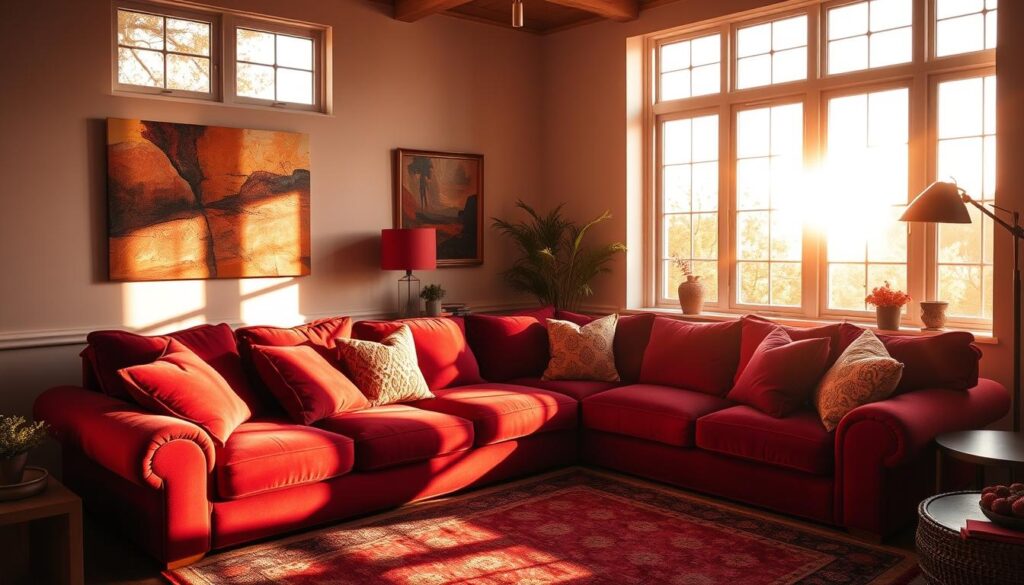
Orange: Creativity, Enthusiasm, and Warmth
Orange is a warm and inviting color that fosters creativity and enthusiasm. It’s an excellent choice for home offices or playrooms where imagination and energy are encouraged. Orange hues can range from soft peach tones to vibrant coral, offering versatility in design.
Yellow: Happiness, Optimism, and Mental Stimulation
Yellow is a bright and cheerful color associated with happiness and optimism. It can mentally stimulate occupants and is often used in kitchens and breakfast nooks to start the day on a positive note. Different shades of yellow, from buttery softness to vibrant daffodil, can be used to achieve the desired effect.
| Color | Emotional Impact | Ideal Room |
|---|---|---|
| Red | Passion, Energy | Dining Room |
| Orange | Creativity, Enthusiasm | Home Office/Playroom |
| Yellow | Happiness, Optimism | Kitchen/Breakfast Nook |
The Psychological Effects of Cool Colors
Cool colors, encompassing blues, greens, and purples, are known to induce a sense of calm and serenity in interior spaces. These hues can significantly influence the ambiance of a room, making them a crucial consideration in color psychology for interior design.
Cool colors are often associated with feelings of tranquility and relaxation. By incorporating these colors into your home decor, you can create a peaceful environment that promotes mental well-being.
Blue: Calm, Serenity, and Focus
Blue is a calming color that can evoke feelings of serenity and focus. Lighter shades of blue can make a room feel more spacious, while darker shades can add depth and coziness.
Benefits of Blue:
- Promotes relaxation
- Enhances focus
- Creates a sense of calm
Green: Balance, Harmony, and Renewal
Green is a balancing color that can bring harmony and renewal to a space. It’s particularly effective in areas where you want to reduce stress and promote well-being.
Green’s soothing effects make it an ideal choice for bedrooms and living rooms.
| Color | Effects | Ideal Use |
|---|---|---|
| Blue | Calm, Serenity, Focus | Bedrooms, Study Areas |
| Green | Balance, Harmony, Renewal | Living Rooms, Bedrooms |
| Purple | Luxury, Creativity, Spirituality | Living Rooms, Meditation Areas |
Purple: Luxury, Creativity, and Spirituality
Purple is a rich, luxurious color that can add creativity and spirituality to a room. It’s often used in spaces where you want to inspire imagination and luxury.
By thoughtfully incorporating cool colors like blue, green, and purple into your decor, you can enhance your living space with color psychology decorating ideas that promote relaxation and well-being.

Neutral Colors and Their Subtle Influence
In the realm of home decor, neutral colors are the unsung heroes, providing a balanced and sophisticated backdrop for any space. These versatile shades can work wonders in creating a clean and elegant atmosphere, allowing bolder decor pieces to take center stage.
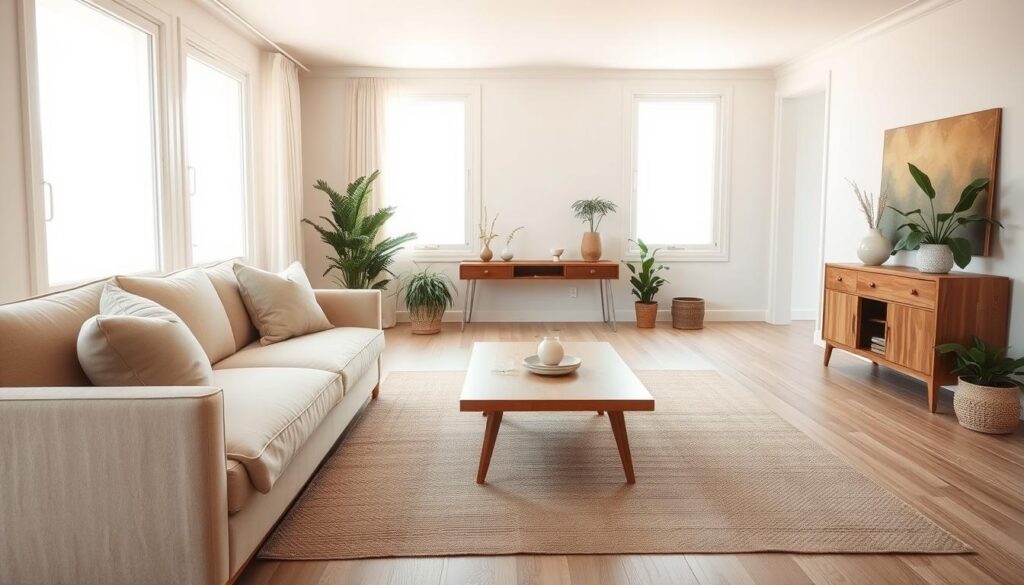
White: Purity, Cleanliness, and Spaciousness
White is a timeless choice in home decor, symbolizing purity and cleanliness. It can make rooms appear more spacious and is particularly effective in areas where a sense of openness is desired. Using white in your design can also enhance the sense of brightness, making it ideal for rooms with limited natural light.
Black: Sophistication, Drama, and Power
Black adds a touch of sophistication and drama to any room. It’s a powerful color that can be used to create a focal point or add depth to a space. When used judiciously, black can bring a sense of luxury and elegance to your home decor.
Gray, Beige, and Brown: Stability, Reliability, and Earthiness
Neutral tones like gray, beige, and brown are essential for creating a stable and reliable atmosphere. These earthy shades bring warmth and coziness to a room, making them perfect for living areas and bedrooms. They also provide a versatile backdrop for incorporating other colors and textures through furniture and decor. As noted by interior design experts, “Neutrals like beige, gray, and white can work wonders too! These versatile shades create a clean and sophisticated backdrop, allowing you to play with bolder decor pieces.”
By understanding the subtle influence of neutral colors, homeowners can make informed decisions when designing their living spaces. Whether you’re aiming for a modern, sleek look or a cozy, traditional atmosphere, neutral colors offer a foundation that can be tailored to suit any style.
Room-by-Room Color Psychology Guide
To elevate your home’s atmosphere, it’s essential to consider the psychological effects of colors on a room-by-room basis. Applying color psychology in home decor can significantly enhance the ambiance and functionality of each space. Professionals often use the 60-30-10 rule to balance the amount and type of color they bring into each room, ensuring a harmonious and effective color scheme.
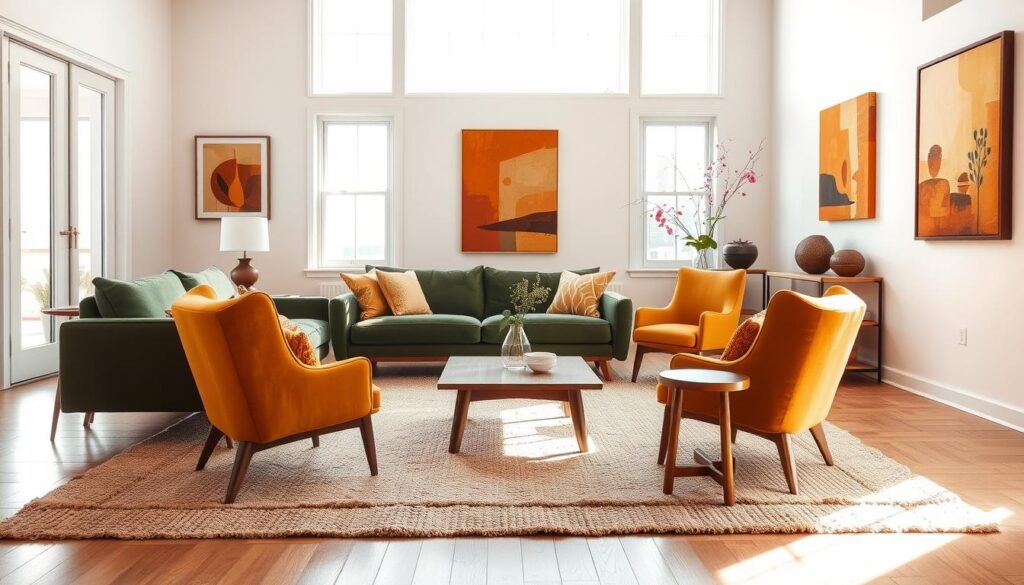
Living Room: Creating Connection and Comfort
The living room is a social space where families and friends gather. Using warm, inviting colors can foster connection and comfort.
Best Color Combinations for Social Spaces
Consider earthy tones like beige and brown, complemented by vibrant accent colors to stimulate conversation.
Accent Colors That Enhance Conversation
Colors like orange and red can increase energy and encourage interaction among guests.
Bedroom: Designing for Rest and Relaxation
The bedroom should be a sanctuary for rest. Cool, soothing colors can promote relaxation and improve sleep quality.
Sleep-Promoting Color Palettes
Soft blues and greens are known to create a calming atmosphere conducive to restful sleep.
Creating Morning Energy with Strategic Color Placement
Incorporating warm colors like yellow or orange in bedding or decor can help stimulate morning energy.
Kitchen: Stimulating Appetite and Energy
The kitchen is a space where appetite and energy are crucial. Warm colors like red and orange can stimulate these aspects.
Home Office: Enhancing Productivity and Focus
A home office requires colors that enhance productivity and focus. Blues and greens are often recommended for their balancing effects.
| Room | Recommended Colors | Effect |
|---|---|---|
| Living Room | Warm earthy tones with vibrant accents | Encourages social interaction |
| Bedroom | Cool blues and greens | Promotes relaxation and sleep |
| Kitchen | Warm reds and oranges | Stimulates appetite and energy |
| Home Office | Blues and greens | Enhances productivity and focus |
Color Combinations and Schemes That Work
Understanding effective color schemes is key to transforming your home’s aesthetic appeal. Choosing the right color combination depends on your goals and the atmosphere you want to create in your living spaces.
Complementary Color Pairings
Complementary colors are pairs of colors that are opposite each other on the color wheel. Using complementary color pairings can create a visually appealing contrast in your home decor. For example, pairing blue with orange or red with green can add energy to a room.
Analogous Color Schemes
Analogous color schemes involve using colors that are next to each other on the color wheel. This creates a harmonious and soothing palette. For instance, combining shades of blue, green, and yellow can create a calming atmosphere in your living room.
Monochromatic and Neutral Palettes
Monochromatic color schemes involve using different shades of the same color, creating a cohesive look. Neutral palettes, which include shades of white, gray, and beige, can make a space feel calm and sophisticated. These schemes are ideal for creating a sense of serenity in bedrooms or living areas.
| Color Scheme | Description | Example |
|---|---|---|
| Complementary | Colors opposite each other on the color wheel | Blue and Orange |
| Analogous | Colors next to each other on the color wheel | Blue, Green, Yellow |
| Monochromatic | Different shades of the same color | Various shades of Blue |
By understanding and applying these color schemes, you can enhance the aesthetic appeal of your home and create the desired atmosphere in each room.
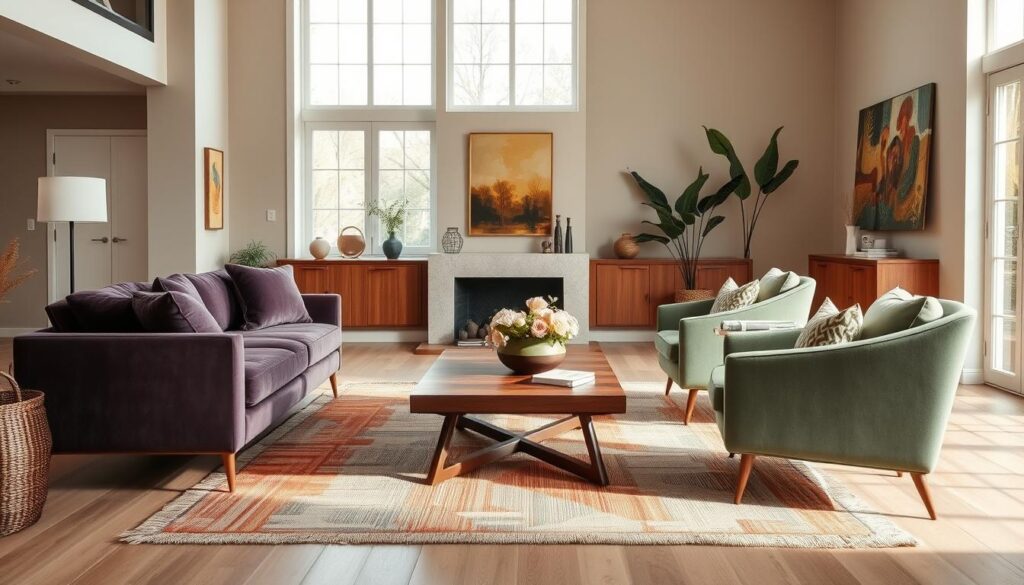
Practical Applications of Color Psychology in Small Spaces
The strategic use of color psychology can transform small spaces into feeling more spacious and welcoming. In smaller homes, the right color choices can significantly impact how open and airy a room feels.
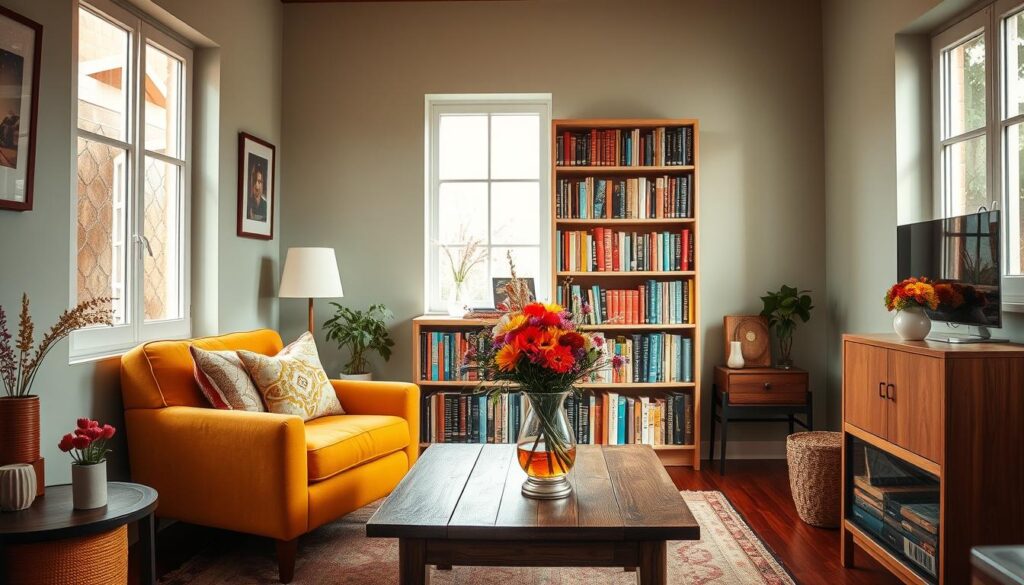
Color Tricks to Make Rooms Appear Larger
To make rooms appear larger, it’s essential to use lighter shades on walls and ceilings. Lighter colors reflect light, creating an illusion of more space. Neutral tones are particularly effective as they provide a clean backdrop for adding accent walls or unique finishes. For instance, using a soft white or cream on walls can make a room feel more expansive.
Strategic Color Placement in Compact Areas
In compact areas, strategic color placement can enhance the sense of space. Using a monochromatic color scheme can create a sense of continuity, making the space feel larger. Additionally, placing a bold color on a single accent wall can draw the eye to that area, distracting from the room’s compact size. It’s also effective to use lighter colors on lower furniture pieces and darker shades on higher elements to create a sense of balance.
Cultural and Regional Influences on Color Perception
Understanding the cultural and regional nuances of color is crucial for creating a home that truly reflects your identity. Color is personal! What resonates with you might not resonate with someone else, and that’s what makes your home uniquely yours.
Colors can have different meanings in various cultures, influencing how we perceive and experience our living spaces. For instance, while white is often associated with purity and cleanliness in Western cultures, it’s associated with mourning in many Asian cultures.
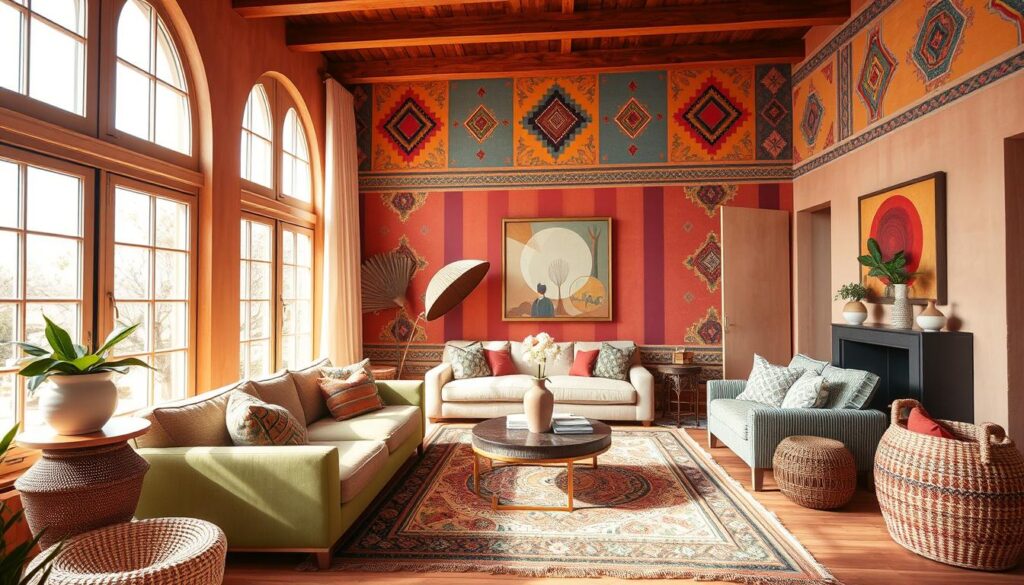
Western vs. Eastern Color Symbolism
The symbolism of colors varies significantly between Western and Eastern cultures. In Western societies, colors like red and orange are often linked to energy and passion, whereas in some Eastern cultures, red symbolizes good luck and prosperity.
- In Western cultures, blue is often associated with trust and stability.
- In many Eastern cultures, blue can symbolize immortality or spirituality.
Regional Color Preferences in American Home Design
Regional preferences in the United States also play a significant role in shaping color choices for home decor. For example, the coastal regions often favor calming, ocean-inspired colors, while the Southwest is known for its warm, earthy tones.
- The Northeast often incorporates traditional and classic color schemes.
- The West Coast is known for its laid-back, natural color palettes.
By understanding these cultural and regional influences, you can make informed decisions about the color scheme in your home, creating a space that not only reflects your personal style but also resonates with the cultural and regional context in which you live.
Seasonal Color Trends and Timeless Choices
Incorporating seasonal colors into your home decor can significantly impact the ambiance and feel of your living spaces. As the seasons change, our homes can become a reflection of the world outside, creating a harmonious connection between indoors and outdoors.
Adapting Your Color Scheme Throughout the Year
One of the best parts about using color in your home decor is the ability to change things up with the seasons. You can create a cozy atmosphere in fall with warm autumn hues, while bright pastels bring a sense of renewal in spring.
Spring and Summer Refreshes
During spring and summer, consider incorporating light, airy colors like pastels, whites, and soft greens to create a refreshing atmosphere. These colors can help make your space feel larger and more inviting.
Fall and Winter Coziness
As fall and winter approach, switch to warmer, richer tones like oranges, reds, and deep browns to create a cozy and intimate ambiance. These colors can make your home feel snug and welcoming.
Evergreen Color Combinations That Never Go Out of Style
While seasonal colors are fun, some color combinations remain timeless. Consider pairing neutral tones like beige, gray, or taupe with a bold accent color for a look that works year-round. Some popular evergreen combinations include:
- Soft gray and creamy white
- Taupe and sage green
- Warm beige and rich wood tones
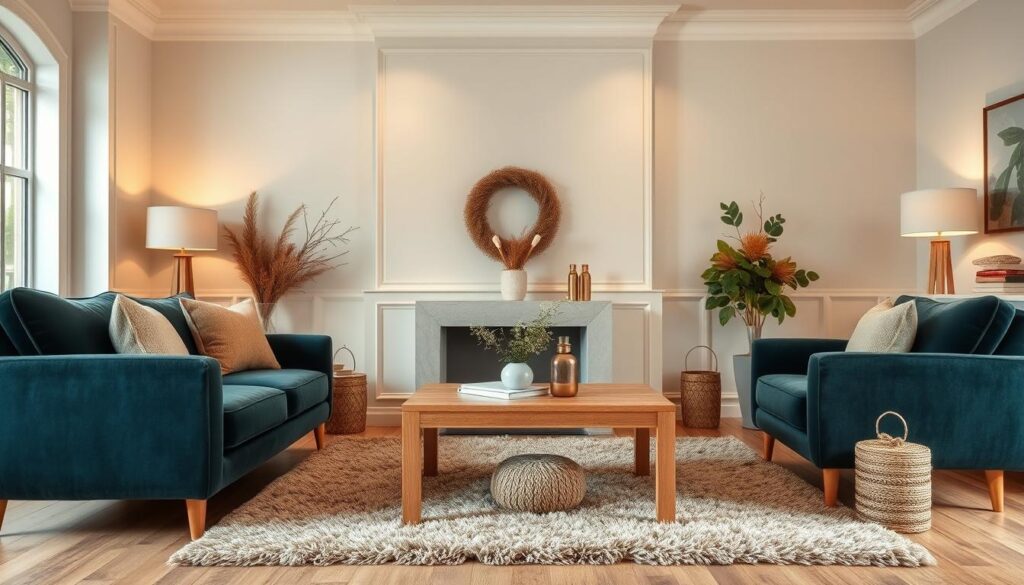
Common Color Psychology Mistakes to Avoid
Color psychology plays a significant role in home decor, but it’s easy to make mistakes that can affect the ambiance of your space. When applying color psychology principles, it’s crucial to be mindful of several common pitfalls that can impact the overall feel and functionality of your home.
Overwhelming Spaces with Too Many Colors
Using too many colors in a single space can create visual chaos and make a room feel disjointed. To avoid this, it’s essential to select a limited palette and stick to it. Consider buying paint samples to test colors before committing to a specific shade. This allows you to see how different colors interact with each other and with the lighting in your space.
Ignoring the Impact of Lighting on Color Perception
Lighting can dramatically alter how colors appear in a room. Both natural and artificial light sources can affect color perception, making it vital to consider lighting when choosing your color scheme.
Natural vs. Artificial Light Considerations
Natural light changes throughout the day, influencing how colors are perceived. Artificial lighting, such as lamps and overhead lights, can also impact color appearance. Warm white lighting can enhance warm colors, while cool white lighting can accentuate cool tones.
How Light Temperature Affects Color
The temperature of light, measured in Kelvin, affects how colors are displayed. Warm light (lower Kelvin values) can make colors appear more yellow or red, while cool light (higher Kelvin values) can make them appear bluer. Understanding this can help you choose colors that work well under different lighting conditions.
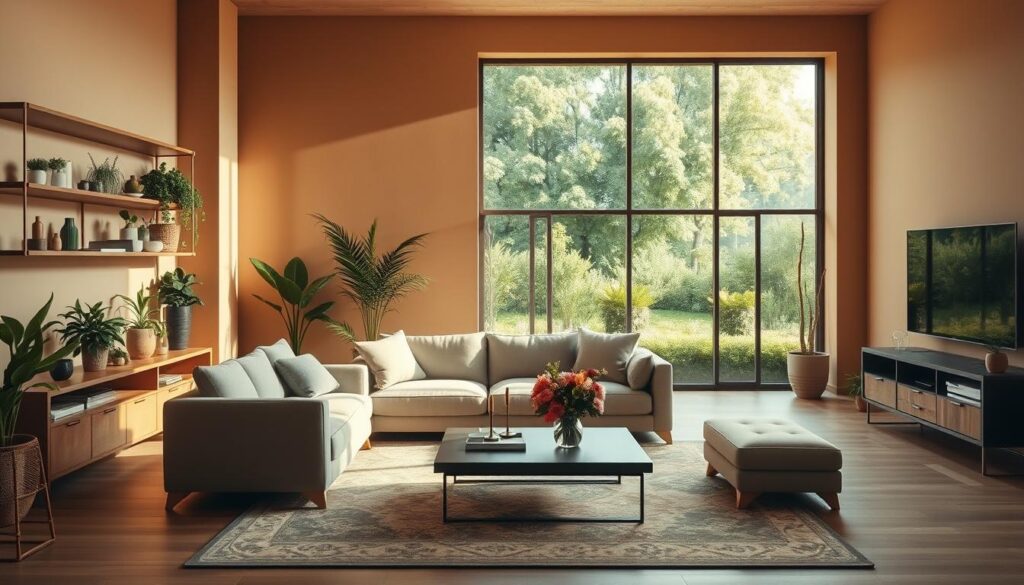
Conclusion: Creating Your Personal Color Story
With the magic of color psychology, you can create a home that not only looks fabulous but also feels amazing. By understanding how different colors impact your mood and behavior, you can make informed decisions when it comes to home decor color psychology.
Experimenting with various color psychology decorating ideas can help you discover the perfect palette for your space. Whether you’re looking to stimulate creativity, promote relaxation, or boost energy, the right colors can make all the difference.
As you’ve learned, color psychology in home decor is not just about aesthetics; it’s about creating an environment that supports your well-being. By applying the principles outlined in this article, you can craft a space that reflects your personality and meets your needs.
So, grab those paint swatches, have fun exploring different hues, and let your personality shine through every vibrant color. With color psychology, the possibilities are endless, and your dream home is just a brushstroke away.



